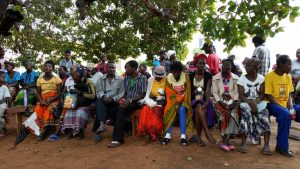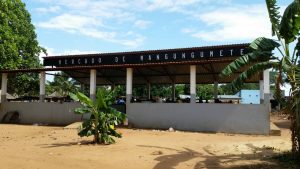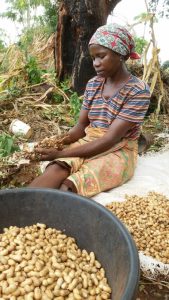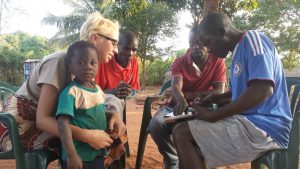Mangungumete Market Latrine Project – Mozambique
This project is made possible through the partnership of WATER CHARITY and the NATIONAL PEACE CORPS ASSOCIATION. ![]()
 Location
Location
Mangungumete, Inhassoro District, Inhambane Province, Mozambique
Community Description
Mangungumete is a small village of about 5,000 people, but the surrounding area is composed of 25,000, all who come to Mangungumete for its small health center and larger market selection. There is a small police station and primary school, but for all other resources, such as secondary school and government offices, one must travel to the bigger nearby towns.
Mangungumete is located on the National Highway between its district capital (Inhassoro) and the neighboring district capital (Vliankulo). While transportation is available to these towns, very few people have the money for such visits.
Everyone speaks the local language (Xitswa) and less than 60% can speak very basic Portuguese, the national language. The majority of the village lives in a straw hut and works on farms, planting peanuts, beans and corn. But, with the drought the past three years, and the average family (5 children) earning only $100 per month, a lot of people are struggling to feed their large families.
 The youth mostly attend school, but missing a week or so to do farming is not unheard of. Combined with other social issues, the population’s average education level is about 5th grade. While this limits the opportunities for the community to better itself, the lack of health education is the most damaging. Many do not understand basic prevention and treatment options for common illnesses caused by unsanitary conditions or improper handling and storing of food. Therefore, the majority of the population often falls sick.
The youth mostly attend school, but missing a week or so to do farming is not unheard of. Combined with other social issues, the population’s average education level is about 5th grade. While this limits the opportunities for the community to better itself, the lack of health education is the most damaging. Many do not understand basic prevention and treatment options for common illnesses caused by unsanitary conditions or improper handling and storing of food. Therefore, the majority of the population often falls sick.
Problem Addressed
The market of Mangungumete does not have any bathroom facilities, thus forcing the population to use unsanitary methods of urination and defecation when at the market. This is especially true for the 150+ vendors who stay at the market all day. The entire village of around 5,000 people, sharing only 6 water pumps, results in very limited personal hygiene and sanitary conditions.
Project Description
This project is to build a public bathroom in the marketplace.
 Location:
Location:
The bathroom/latrine facility will be located within the ‘new market’ section of the town’s market. The structure will be 15 meters away from all current vendor stalls. This follows the norms and regulations for public latrine placement.
It is in an open, central and visible location, which will help with the increased use of this facility and abandonment of the current practice of public urination/defecation behind stalls within the market. The location reduces the risk of assault because there are no narrow allies leading to/from the facility.
The Building:
The structure will be a 3-meter by 3-meter cement block building with a tin metal roof, built on firm ground. It will be divided in half and have 8 block ventilation ‘windows’ and 2 wooden doors. One room will be for urination and the other for defecation. This is a standard latrine structure in the area and what the community voted for.
The floors will be cement. In the center of each room, there will be a cement platform for people to squat over. The system will be the same for both rooms: an inclined plastic pipe will lead from the hole to the sewage tank, which is located off to the side. There will be a bucket of water there for the people the flush waste down to the tank.
Sewage Tank:
Next to the facility, a 5-meter deep hole, 1-meter by 1-meter square, will be dug. The hole will be lined with cement blocks all the way up. This wall will prevent the damp sand from caving in and filling in the hole. There will also be a cement divider with little holes placed halfway deep into the sewage tank. Liquids will seep through those holes into the bottom hole and the gravel below and then the ground; the solids will remain in the top half of the tank. This will allow the tank to fill primarily with solid waste, and not liquid, thus extending that lifespan. This is the common and approved practice when building public latrines in this area.
The lid to the tank will be cement and have a plastic pipe leading out at a 90-degree angle, to allow for ventilation. The end of the pipe will be covered with netting to prevent insects from entering. This ventilation will help decrease the smell and also help with drying out the solids.
A wide tube will lead from each “toilet” to the sewage tank. A single sewage tank will receive both the urine and feces for cost-saving purposes. The divider will then allow urine and the flushing water to separate from the waste solids. Culturally, it is still important to have a place to urinate that is separate from that for defecation — thus the two identical rooms.
 The water table is 20-25 meters deep. According to a civil engineer at the infrastructure office at the district’s capital, this 5-meter sewage tank will not contaminate Mangungumete’s water supply.
The water table is 20-25 meters deep. According to a civil engineer at the infrastructure office at the district’s capital, this 5-meter sewage tank will not contaminate Mangungumete’s water supply.
This system was chosen because if the tank fills up, the town can easily dig another tank and continue to use the original building. This system will help with the sustainability of this project. Community leaders anticipate that the tank will last 15-20 years.
Guard House:
A small guardhouse will be built right next to the bathroom facility. It will be a 1.5-meter by 1.5-meter building made of cement blocks, and have a tin metal roof. There will be 3 block ventilation “windows” and a wooden door. This is where the guard will sit and collect a small fee (less than a penny) per person that uses the latrine. The mops, buckets and other cleaning supplies will also be stored here. This collected money will be used to pay the guard’s salary and maintenance fees and will fund any future purchases, such as soap. This person will also ensure the cleanliness of the bathroom/latrine.
Sink:
Outside of the bathroom/latrine facility and in-between the 2 doors there will be a metal sink with running water. This sink will serve the dual purpose of a handwashing station and filling station for the buckets to ‘flush’ and to clean the facilities. The pipes will draw water from the water tank at the police station located 20 meters away. This has been approved by the leadership at the district capital, the leadership in Mangungumete, and the police.
End of Project ‘Health Day’:
To celebrate the project’s completion, there will be a health-themed event attended by the market vendors and the greater community. Some of the event activities will include: health talks, and interactive games teaching proper sanitation and personal hygiene (such as washing hands after using such facilities and before handling food, which is especially important for the market vendors).
A youth group will also paint murals on the bathroom/latrine walls to serve as a constant reminder of proper hygiene and other healthy habits like using a bug net.
Project Impact
5,000 people will benefit from the project.
Peace Corps Volunteer Directing Project
Leah Kirby
Monitoring and Maintenance
Planning has included all counterparts to ensure that they are actively learning and are part of the decision-making process for this project. Skill building and learning are fundamental parts of the project.
The appointment of a person to guard the latrine and lock it during the night will result in a facility that is always properly clean and safe for all to use for many years.
Fundraising Target
$1,850
Donations Collected to Date
$1,850
Dollar Amount Needed
$0 – This project has now been fully funded through the generosity of the Robert Victor Sager and Beatrice Mintz Sager Foundation.
Additional donations will be used for other projects in Mozambique.
This project has been completed. To read about the conclusion of the project, CLICK HERE.![]()